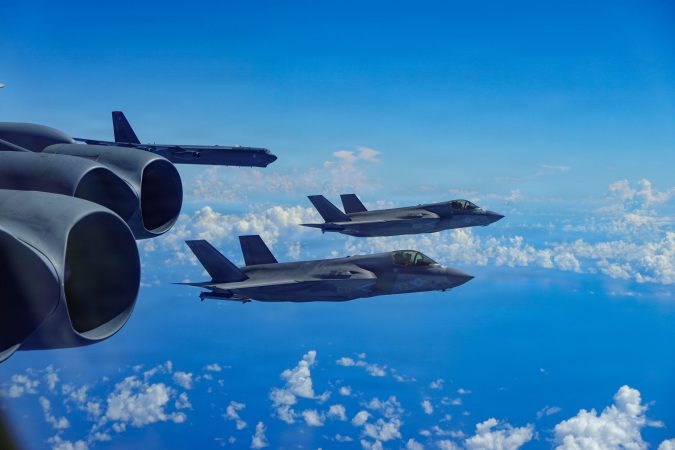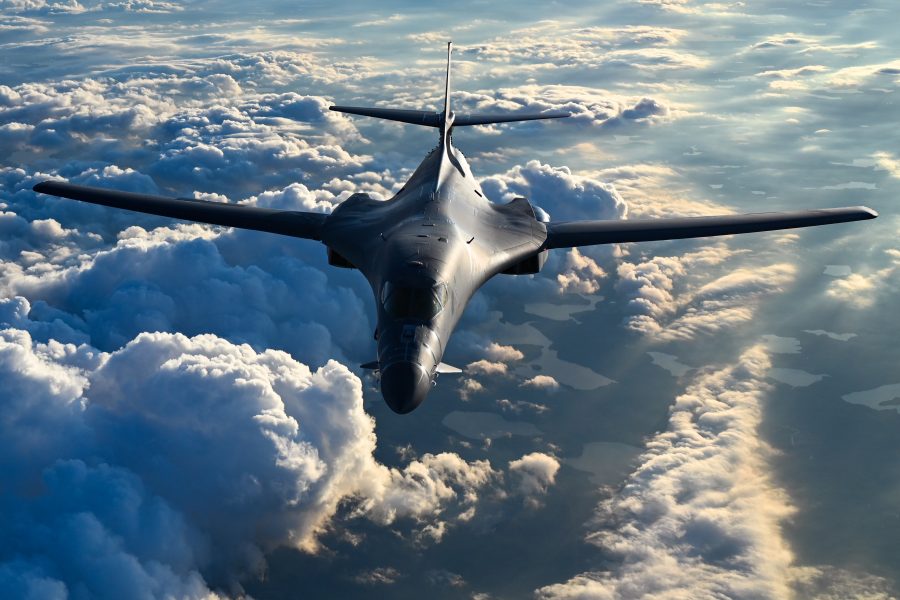Multiple Air Force B-1B Lancer bombers flew near Venezuela on Oct. 27 in the latest U.S. show of force aimed at Caracas and drug cartels from the Latin American country, people familiar with the matter told Air & Space Forces Magazine.
The mission off the coast of Venezuela marked the third such bomber flight since Oct. 15. U.S. military officials have described the flights as “bomber attack demonstrations.” As with the previous flights, the B-1s were visible on open-source flight tracking websites—an indication that the Pentagon was making no attempt to hide the flight. At one point, the B-1s were roughly 20 miles from Venezuela, flying off of the country’s northern coast—the closest the three bomber missions have come to date.
The military operations are part of a broader pressure campaign on drug cartels and the regime of Venezuelan President Nicolas Maduro, who the White House says is an illegitimate leader. President Donald Trump has said on multiple occasions that the U.S. may strike targets on land.
The U.S. military has conducted the show-of-force bomber flights roughly once a week, a pattern that shows no signs of stopping, people familiar with the matter said.
B-1s are capable of carrying standoff cruise missiles and guided bombs that could be used in possible strikes on land. On Oct. 24, Secretary of Defense Pete Hegseth ordered the USS Gerald R. Ford Carrier Strike Group, including its carrier air wing, to Latin America, the Pentagon said, significantly bolstering the already sizable airpower presence near Venezuela. And on Oct. 26, the USS Gravely guided-missile destroyer docked in Port of Spain, Trinidad and Tobago, an island nation off the coast of Venezuela.
The bombers took off from Grand Forks Air Force Base, N.D., and proceeded south with their transponders on, open-source flight-tracking data showed. The B-1s refueled over Florida with several tankers from MacDill Air Force Base, Fla., before heading further south.
Navy P-8 Poseidon surveillance aircraft were also active in the region on Oct. 27.
On Oct. 23, two B-1B Lancers flew near Venezuela after taking off from Dyess Air Force Base, Texas. On that mission, the bombers flew roughly 50 miles off the coast of Venezuela.
A week earlier, three B-52H Stratofortress bombers from the 2nd Bomb Wing at Barksdale Air Force Base. La., joined armed Marine Corps F-35B stealth fighters, 10 of which are based in Puerto Rico, and flew orbits off the coast of Venezuela.
In all three flights, the active transponders indicated the bombers did not attempt to hide their presence and provided data about their movements. It is unclear if the B-52s or B-1s were armed for any flights.
The Office of the Secretary of Defense and Air Force Global Strike Command, which oversees America’s bomber fleet, declined to comment on the Oct. 27 mission.
The Air Force has bulked up its presence in the region in recent weeks. Multiple armed AC-130J Ghostrider II gunships have been operating out of Puerto Rico, in addition to at least six different MQ-9 Reapers. Both AC-130J Ghostrider gunships and MQ-9 Reaper drones have been photographed with live Hellfire missiles, and the Marines’ F-35s have been carrying live air-to-air missiles in photos released by the U.S. military, including during their mission with the B-52s.

In addition to the Marine Corps F-35Bs stationed on land, USMC AV-8 Harrier fighter jets, AH-1 attack helicopters, and other aircraft are embarked on the USS Iwo Jima, an amphibious assault ship that has been operating in the region, along with a number of destroyers and the Special Operations ship MV Ocean Trader. The Harriers and helicopters have conducted live-fire exercises this month.
The bomber flights come as the Trump administration has said the U.S. is in an “armed conflict” with drug cartels it has deemed “unlawful combatants,” claiming the authority to conduct strikes against alleged drug-smuggling efforts. At least 43 people have been killed in the U.S. airstrikes. The lethal boat strikes have not been authorized by Congress, and some lawmakers and former Pentagon officials have argued the attacks are not legal. The U.S. has not presented evidence that the boats are carrying drugs. In the past, the U.S. Coast Guard, sometimes with the assistance of the Navy, has interdicted suspected drug boats. Two survivors of an Oct. 16 strike were briefly held aboard a U.S. Navy ship, as the U.S. elected not to hold them as prisoners of war or charge them with a crime, and instead said it sent them to their home countries of Ecuador and Colombia.
While the U.S. has said drug smugglers are its primary priority, the administration is also seeking to pressure Maduro, Venezuela’s authoritarian ruler, from power. Maduro has been charged in the United States for being involved in a conspiracy to smuggle cocaine and guns into the U.S., and the Trump administration is offering $50 million for information that leads to his arrest.
This article was updated Oct. 29 with additional information.


